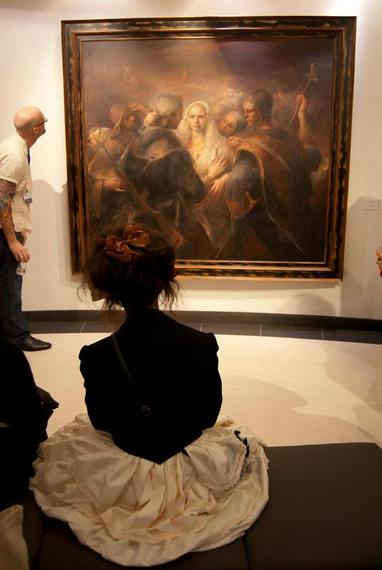 Artist Teresa Oaxaca admires Odd Nerdum's The Poacher at TRAC 2014
Photo by Brittany McGinley
Artist Teresa Oaxaca admires Odd Nerdum's The Poacher at TRAC 2014
Photo by Brittany McGinley
I often tell people that there isn't just one Art World, and on Wednesday, March 5th two divergent art events taking place on opposite coasts of the United States would have proved my point and then some. Let's start with the West Coast...
In Ventura, California March 5th was the closing day of the second ever Representational Art Conference --
TRAC 2014 -- an international gathering that had attracted over 300 artists and others interested in exploring "the aesthetic principles and values implicit in the representational art of the 21st Century." The TRAC conference has tripled in size since it first appeared in 2012, and this year's attendees often found themselves spilling out the back doors and leaning against walls, listening raptly to presenters and panel discussions.
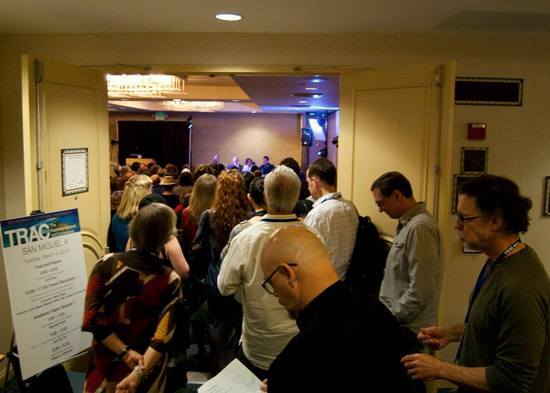 The crowd overflows during a TRAC panel discussion
Photo by Brittany McGinley
The crowd overflows during a TRAC panel discussion
Photo by Brittany McGinley
During TRAC's opening evening on Sunday, March 2nd crowds sat six rows deep as they took in a four-ring circus of technical demonstrations and lectures. They alternated between watching a live oil portrait demonstration by Tony Pro and a demonstration of the use of gold leaf in mixed-media by Pam Hawkes. In another corner sculptor Stephen Perkins offered a demo in which he confidently modeled a clay ecorché figure while giving tips on human anatomy. Across the room artist Graydon Parrish and his co-presenter Steve Linberg donned white lab coats while explaining the systematic intricacies of the
Munsell Color System.
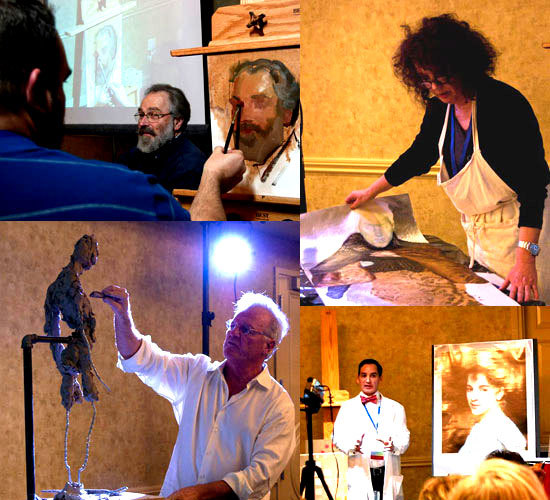 TRAC Demonstrators - from upper left then clockwise
Tony Pro (painting Virgil Elliot), Pam Hawkes, Stephen Perkins and Graydon Parrish
TRAC Demonstrators - from upper left then clockwise
Tony Pro (painting Virgil Elliot), Pam Hawkes, Stephen Perkins and Graydon Parrish
The second morning of the conference opened with a breakfast talk by Roger Scruton, a British philosopher, and the host of the BBC documentary
Why Beauty Matters. Scruton argues that
fake ideas and fake emotions have banished beauty from High Culture.
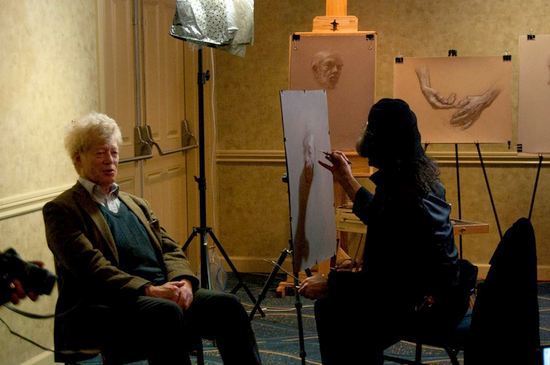 Alexey Steele demonstrates drawing with Roger Scruton as his model
Photo by Brittany McGinley
Alexey Steele demonstrates drawing with Roger Scruton as his model
Photo by Brittany McGinley
A sober and articulate Scruton lamented the series of "jokes" in contemporary art going all the way back to Marcel Duchamp's urinal -- a word which he pronounced with evident distaste as
yur-eye-null -- arguing that authenticity and "real" art offered the antidote to Duchamp's derailment of art's true purposes. Railing against the "fake originality" of much modern and contemporary art -- Jeff Koons was one target of his wrath -- Scruton has positioned himself as an advocate for narrative art that offers its viewers the possibility of redemption.
Roger Scruton at TRAC 2014: video by John Seed (39 seconds)
Scruton gave the conference its philosophical and moral center, when he told his listeners: "You should be able to go to art with the burden of your life." At the close of his breakfast address, Scruton received a standing ovation, leaving the crowd excited, caffeinated and ready for the panels and papers to follow.
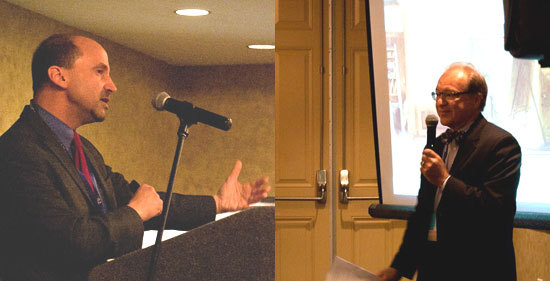 L to R: Peter Trippi and Michael Zakian
Photos by Brittany McGinley
L to R: Peter Trippi and Michael Zakian
Photos by Brittany McGinley
After breakfast I listened to Peter Trippi, the Editor of
Fine Art Connoisseur Magazine who offered a shrewd blend of insight and advice in his presentation:
So, Great Art Is Being Made Today: Who's Selling and Buying It, Why and How? "Mark my word," he announced at one point: "Within 25 years the only public commercial galleries left in New York City will be tourist oriented storefronts within walking distance of each other." Just as Trippi was finishing I heard applause ring through the hotel walls when Michael Zakian, the Director of the Frederick Weisman Museum at Pepperdine University completed his talk on
The Problem of Content in Contemporary Realism.
After lunch the events just kept coming. There were 18 academic paper presentations to choose from --
The Quest for Beauty Through Classical Proportion Systems was one -- followed by an excursion to Cal Lutheran University to view two exhibitions:
Women by Women and
Resonating Images III.
 Roger Scruton and Odd Nerdrum: Photo by Betty Shelton
Roger Scruton and Odd Nerdrum: Photo by Betty Shelton
The following day brought the conference's much-awaited centerpiece -- a conversation between philosopher Roger Scruton and artist Odd Nerdrum, the event's rock-star presence. The crowd listened raptly when Nerdrum explained that just as American soldiers in Afghanistan had been told to "shoot at anything that looked like a Rembrandt portrait" contemporary art historians had been trained to "kill all pictures that look like a Rembrandt."
Nerdrum, who later commented that he sees himself as a kind of Hell's Angel -- a rebel operating outside official culture -- also offered his opinion that "the art historians in the universities have the same power as the American soldiers have in the world." He also recounted meeting the late art historian Arthur Danto who struck Nerdrum as being "like a school teacher" ready to enforce the authoritarian rules of art. Nerdrum came across as alternately sweet and over-dramatic and seemed to genuinely appreciate the attention he was receiving.
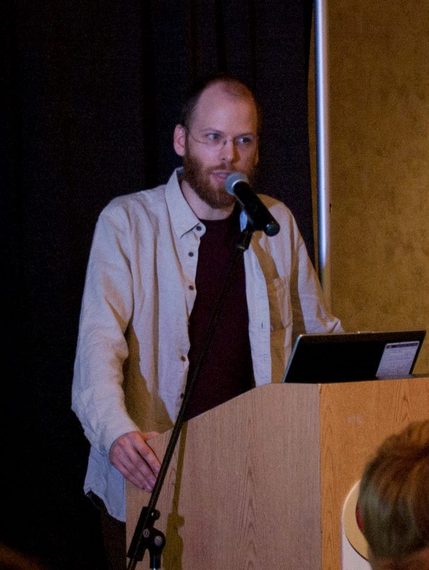 Jan-Ove Tuve
Photo by Brittany McGinley
Jan-Ove Tuve
Photo by Brittany McGinley
The afternoon was devoted to a full schedule of presentations on the
School of Nerdrum by some of the artist's students and friends. His associate Jan-Ove Tuv, for example, took on the topic of kitsch -- the art world's n-word -- in a presentation titled
Kitsch as Superstructure for Representational Narrative Painting. After the Nerdrum seminars ended a line of sleek limo-buses took anyone with any energy left to the exhibition
Fresh Harvest by Michael Lynn Adams -- one of TRAC's co-founders -- at the Ventura Museum of Art.
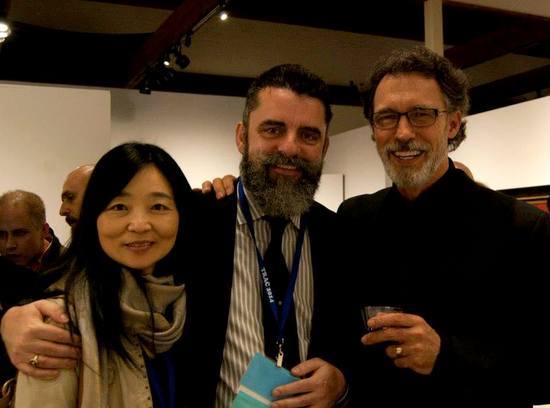 Artist Aihua Zhou with TRAC co-founders Michael Pearce and Michael Lynn Adams
Photo by Brittany McGinley
Artist Aihua Zhou with TRAC co-founders Michael Pearce and Michael Lynn Adams
Photo by Brittany McGinley
During the closing day's panel discussion
The Future of Representational Art there was a heartfelt surge of applause for artist Graydon Parrish as he recounted how he had been given a "F" in a high school art class because his drawing was deemed too "tight." Many other artists in the audience had apparently endured similar attempts at conversion therapy during their years in art school. There were plenty of other anecdotes about art world "rules." Odd Nerdrum says that he has been warned that only vegetarians can paint slaughter scenes, and painter Ruth Weisberg recounted the admonition that only lesbian women should paint the nude female body.
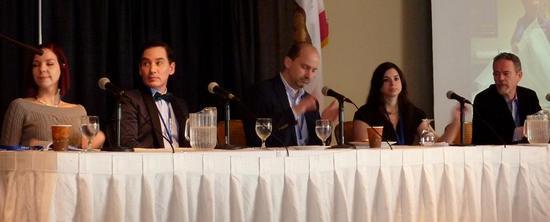 Panel on The Future of Representational Art (L to R)
Candice Bohannon-Reyes, Graydon Parrish, Peter Trippi, Kara Ross, F. Scott Hess
Panel on The Future of Representational Art (L to R)
Candice Bohannon-Reyes, Graydon Parrish, Peter Trippi, Kara Ross, F. Scott Hess
The connections at TRAC were about much more than styles and experiences. Artist Richard Thomas Scott observed after that conference that "What sets us apart is not style, nor the fact that we paint recognizable objects, but our reconstructive humanist philosophy."
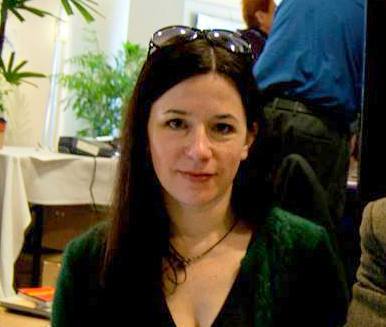 Juliette Aristides: Photo by Brittany McGinley
Juliette Aristides: Photo by Brittany McGinley
TRAC 2014 was brought to a close around noon on March 5th with a talk by the classically trained artist and atelier founder Juliette Aristides. She came straight from the heart and offered the crowd consolation, reminding them that representation is a deep tradition that has persisted for ages. She also referenced other moments in history when artists felt disillusioned with their culture and struck out on their own to "write the stories they want to read."
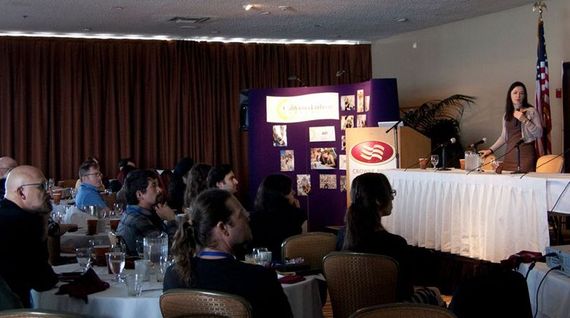 Juliette Aristides speaking at TRAC 2014: Photo by Brittany McGinley
Juliette Aristides speaking at TRAC 2014: Photo by Brittany McGinley
"Art stops the ground from falling, corrects wrongs, and links us back to our own lives," Aristides commented. "Every act matters, every life matters; see the beauty in our own life, our spaces, our places, and make meaning."
Many of those attending TRAC and listening to Aristides were classically trained painters whose careers have been diminished by their adherence to a set of aesthetic and philosophical values that have made them pariahs in the New York-centric world of contemporary art. At TRAC 2014 these same artists found themselves among a surging tide of new friends sympathetic to their point of view and the sense of camaraderie was profound and healing. Tired of being labeled as "kitsch" painters and fuddie-duddies, the TRAC crowd was excited to be in a context where there wasn't anyone present would would accuse them of not being an artist.
TRAC 2014 wasn't without its awkward moments. I suffered through one presentation in which the presenter railed against the work of Mark Rothko, condemned "billionaires buying crap" and then offered his own wife's paintings as a superior alternative. When accusing the art world of being biased and insular it isn't wise to promote the paintings of your family members…
I also couldn't help noting that although TRAC has made every effort to be progressive and open towards its membership there was only one African-American artist at the event. Classically and Academically oriented artists dominated the event but there was plenty of room for "moderates" -- I'm one of them -- who acknowledge and find inspiration in the tradition of representational art with modernist roots. All in all TRAC's flaws were minor and its achievements remarkable. "It felt like a tipping point," says artist Brandon Kralik.
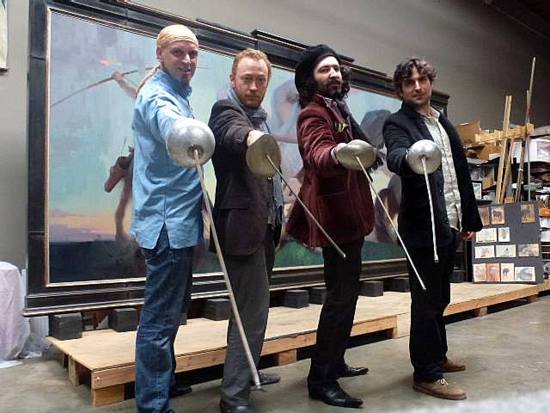 L to R: Brandon Kralik, Richard Thomas Scott, Alexey Steele and Jordon Sokol
L to R: Brandon Kralik, Richard Thomas Scott, Alexey Steele and Jordon Sokol
There isn't a bit of doubt in my mind that a genuine movement is taking shape and a third TRAC conference has been given the green light by Cal Lutheran University, led by its very admirable President Chris Kimball. Who knows what TRAC will morph into, but if it stays flexible and continues to gain momentum it has the potential to reshape the future of contemporary art, especially if it continues to associate itself with representational artists of genuine talent.
***
In theory, you could have heard Juliette Aristide's final address and then boarded a NetJet at the Camarillo airport and made it to New York just in time to catch the 8PM opening cocktail reception for the 2014 Whitney Biennial, which bills itself as offering "one of the broadest and most diverse takes on art in the United States that the Whitney has offered in many years."
 Ken Lum, "Midway Shopping Plaza" (2014)
Powder-coated aluminum and enameled plexiglass
Photo by Caitlin Karolczak
Ken Lum, "Midway Shopping Plaza" (2014)
Powder-coated aluminum and enameled plexiglass
Photo by Caitlin Karolczak
Of course, I take issue with the idea that there is anything broad or diverse in what is on view at the Whitney: calling the Biennial "diverse" ignores the obvious perimeters of the exhibition's taste and ambitions. Tom Wolfe once wrote that the one type of person you never see at a New York cocktail party is a housewife. Classically trained representational artists -- one of the major constituencies present at TRAC -- are the art world's "housewives:" herded by critics and curators into their own separate and unequal social and artistic circle.
 A Detail of Bjarne Melgaard's Installation at the 2014 Whitney Biennial
Photo by Caitlin Karolczak
A Detail of Bjarne Melgaard's Installation at the 2014 Whitney Biennial
Photo by Caitlin Karolczak
Doesn't anyone remember the
September 1995 protest organized by Steven Assael in which some 200 painters gathered outside the Whitney to protest its exclusion of "artists working in a representational mode." The Museum's director at that time, David A. Ross, was out of town during the protest, but he did later issue a statement of reply, noting that the Whitney must support work that "strays outside the boundaries of the official academies and accepted good taste."
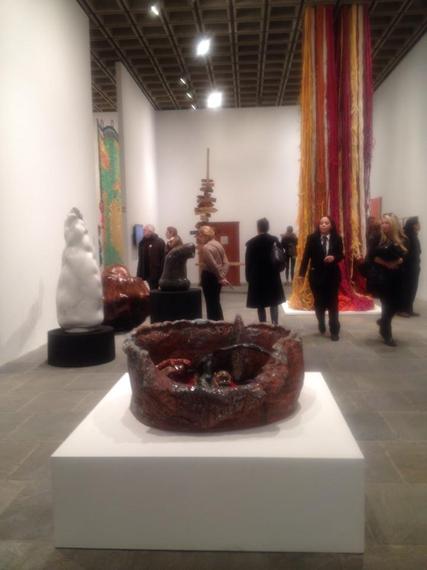 Ceramic Basin by Sterling Ruby in the 2014 Whitney Biennial (foreground)
Sheila Hicks's "Pillar of Inquiry/Supple Column" (background)
Photo by Caitlin Karolczak
Ceramic Basin by Sterling Ruby in the 2014 Whitney Biennial (foreground)
Sheila Hicks's "Pillar of Inquiry/Supple Column" (background)
Photo by Caitlin Karolczak
The painters I spoke with at TRAC take the contrarian view that the Whitney is in fact the confirmed official academy of 21st century art: the Biennial's 103 "participants" chosen by three curators to take part in the show -- are the conservatives, rigidly aligned with the ossified and hypocritical "pluralism" of late postmodernism.
Take a few minutes and watch at least part of James Kalm's video of the exhibition's top floor and you will get a sense of just how shambling and eccentric the 2014 Biennial is...
After watching Kalm's video -- which I think would make a terrific Portlandia episode -- I realized that it would make no sense for me to offer any specific observations about the Biennial at this point. Other critics who have seen the show are already busy doing that, and the reviews range from tepid to scathing. Friends tell me that there are some paintings in the show worth seeing, and I am going to take their word for it.
What really strikes me is that the Whitney missed a big opportunity in 1995. In a way, David Ross made TRAC necessary by failing to open up a conversation that could have changed the course of American art. It may just be an intellectual exercise, but can you imagine what kind of paintings we might be seeing in 2014 if some of the rigor and vitality offered by the painters in Steven Assael's protest group had been hybridized into contemporary American painting?
We know that American politics are tragically divisive at this point in time: does the nation's aesthetic culture have to be divided too? The contrast between the aesthetic vitality I saw at TRAC 2014 and the fatigue visible in the thrift store on steroids aesthetic of the Whitney Biennial makes me... well, just sad.
It seems appropriate to end this blog on a positive note by mentioning something that I like. While viewing
Women by Women during the TRAC conference I came down some gallery stairs to find artist Betty Shelton -- an instructor at the Laguna College of Art and Design -- standing by her painting
Prague's Madame Magdalena de Thebes. I pulled out my smartphone and captured this image of Betty beaming with justified pride. It looks like an extremely fine work of art to me... what do you think?
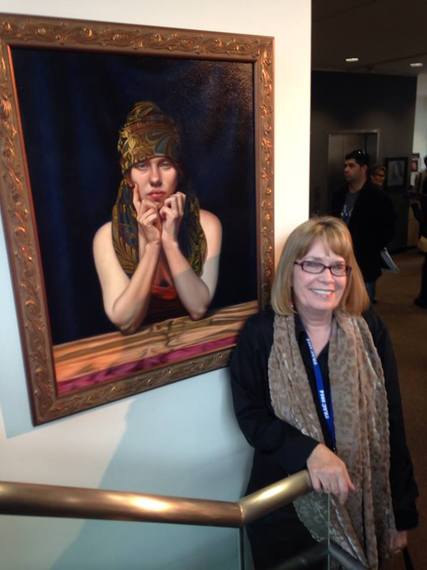 Betty Shelton with her painting Prague's Madame Magdalena de Thebes
Oil on canvas, 35 x 29 in: photo by John Seed
Betty Shelton with her painting Prague's Madame Magdalena de Thebes
Oil on canvas, 35 x 29 in: photo by John Seed
















